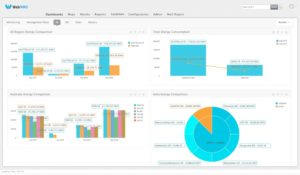WebNMS, a division of US-based Zoho Corp, is an Internet-of-Things (IOT)-based energy management solutions providing company. T&D India caught up with Karen Ravindranath, Director-IOT, WebNMS, at Elecrama 2018, to understand the company’s scope of activities in the power sector. In an interaction with Venugopal Pillai, Karen how industrial consumers can gainfully manage energy consumption and ensure power quality with integrated software solutions from WebNMS.

Can you give us an overview of your operations in the power distribution sector?
Basically, ours is an IOT-based energy management solutions providing company. That is our core. WebNMS is part of a larger Zoho Corporation. We are focusing on providing energy management solutions. This essentially is for two different cases. One is for managing the energy consumption side for all industrial, commercial and residential units, wherever, regular tracking of consumption is required. That solution not only caters to power from the grid but also to green technologies like captive solar plant or battery backups or power is coming from a secondary source like DG set. Everything is monitored on a single software system which gives users a comprehensive picture of how they are consuming energy from different sources, and how this is energy is being used by them.
Do you also look at issues like power quality, etc?
We also look at power factor, power quality, harmonics, etc. This kind of data is accumulated from the energy meters. Based on this data, we do power quality analysis, and create reports, visualizations and dashboards. This helps users to understand how efficiently electricity is being used. It also gives users the opportunity to users to optimize energy consumption. These reports also help identify anomalies, and then rectify them.
What about the second part of your services, which you mentioned?
In the second part of our service, we have partnered with system integrators in order to work with power utilities for monitoring of power transmission lines. Today, power transmission infrastructure is huge. Identifying problems in the power T&D network is difficult simply because such networks cover a large area. We measure the current at each feeder, and help identify where there is failure.
Does this happen in real time?
Yes, these are RF-based modules that are also GSM-enabled. This pushes data to the cloud, helping us to gather real-time data. Utilities are therefore equipped to identify the problem and address it promptly. Reducing response time is a key functionality that we try to provide.

Is WebNMS in talks with state discoms for such services?
We are actually going through our system integrator partners and also looking for more of these partnerships. We need more traction on that side. In a couple of cases, we also went with hardware manufacturers for power transmission monitoring solutions. But definitely we are open to more exposure with power T&D companies.
Given that the generally weak financial health of power utilities, how do you see their response?
So, technology-wise, power T&D utilities see the value in it. But there is some resistance as far the investment aspect is concerned! We have been trying to push our products for the past 2-3 years in the utilities.
Coming back to your first case, who are your clients?
For us, the large energy consumers are in the industrial space. There are manufacturing and processing units that have multi-site plants, across different states. Our solution is basically trying to create an ecosystem where we can monitor the different energy data from all their sites. We can then unify this into a single solution that gives business intelligence to the top management. We have seen our customers have moved away from SCADA or in-house systems sitting in their premises. We have helped our customers to get visibility through a single site, through our unified solution. Consumers can now compare various cost centres. For example, we have engaged with a large battery manufacturer that has three production units across south India. We have deployed our energy solution at all the three sites, and the management can monitor the relative performance at a single point.
Power quality is important for industrial consumers in terms of their own assets (plants). The asset will have problems in the long run when they have bad quality power going into their machinery.
Power utilities are known to impose penalty on industrial consumers that do not maintain a healthy power factor ratio. Is this an opportunity area for you?
Yes, definitely. Power quality is important for industrial consumers in terms of their own assets (plants). The asset will have problems in the long run when they have bad quality power going into their machinery. There is also pressure from utilities to maintain the right kind of power factor (PF) ratio. Even the load drawn by a plant should be in line with what has been sanctioned. This is to ask if there is a situation of overload. A plant owner can find out if the plant is drawing more load over a period of time. This kind of planning can be done once you have unified data.
As we understand, your services are diagnostic in nature. Do you also provide solutions?
We, at WebNMS, engage with energy consultants and auditors. Our system can provide the required data for monitoring, on a real time basis. As opposed to the current trend where energy auditors could possibly visit a site once in a few months to carry out energy audit, we offer you a live system that always gives you real-time data. This gives much more visibility to energy consultants helping them provide technical insights that can help the top management take the right decisions.
Do industrial customers readily appreciate that the expenditure spent on such monitoring services actually pays for itself over a period of time?
In most of the cases, we have seen that we try to reuse the hardware infrastructure that is already there with the customer. We have the capability in our platform to plug and play with the existing hardware. This reduces the initial capex cost. The software is reasonably priced in terms of load points that are monitored. The software is also priced on annualized basis; there is no heavy upfront cost as such. The benefits that consumers see out of it is that the energy efficiency gain can be 20-22 per cent, which considering an industrial power consumer, is very significant. The recovery of such an investment is very much demonstrable, often in the first few months or within the first year.
As we see, most of your solutions are on retrofit basis. Do you also engage with consumers for greenfield projects?
Yes. When we engage with energy consultants and architects, we are able to approach consumers that are setting up greenfield projects. For example, it could be a new manufacturing plant or a commercial establishment.
A software like ours helps industries to the part of this sustainability movement.
How do you see the scope for your services in India?
All over the world, energy efficiency is being stressed upon. In India, we are moving away from fossil fuels. In that aspect, creating efficiency and gauging how your organization is contributing to the cause of carbon footprint mitigation becomes important. A software like ours helps industries to the part of this sustainability movement. As India moves closer to environment-related official deadlines, the government will have policies that expect you to adhere to some standards. A software like this will help you to stay on track, to this effect. Though traction needs to be built up, we are definitely optimistic about the future.


